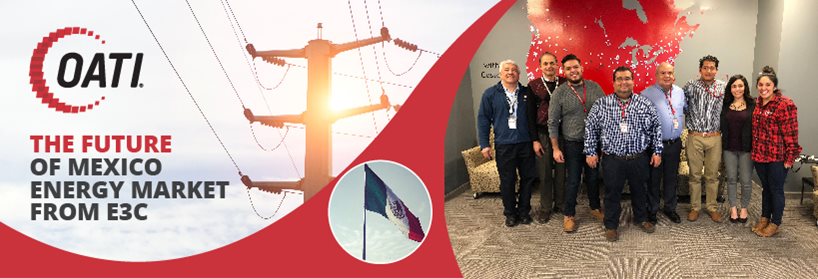Home » Blog » Mexico Wholesale Energy Market » E3C Contemplates the Future of the Mexico Energy Market
E3C Contemplates the Future of the Mexico Energy Market
OATI recently hosted Estrategia Energía Eléctrica (E3C) for a training visit. In the last blog, we discussed the current Mexico Energy Market, some of its strengths and weaknesses, and the uncertainty they face from their potential customers. In this blog we continue the conversation with Mr. Alan and Mr. Antonio’s vision of the future of the Mexico Energy Market.
Q4: What do you see in the future of the Mexico Energy Market?
Alan: In the future, I see a lot of sophistication. Right now I deal with the commercial part of the business and when I visit potential load customers, they don’t even know how to negotiate. What we are trying to sell is like a financial future; we’re selling derivatives. When we’re dealing with the guy who makes purchases for the factory, whose daily work is to get better offers on machines, you have to tell him that energy prices do not work the same way. When you talk with the Chief Financial Officer, they understand it, and that is what’s going to happen. Everyone will have their own energy specialists, not just the bigger entities.
Although Mexico has a lot of potential for solar and wind energy, I think that it will be tough for the MEM to achieve 50% clean energy by 2050. My guess would be 2055 at the earliest. If you ask any regulator, they will tell you, “No, of course we cannot do it.” It’s an ambitious goal, and this is further complicated because the market has been moving slowly. I think we’ll have a better idea as the market grows and matures; a lot of generators have the projects and plans, but the biggest problem is that we don’t know how to finance it. Finance used to be one-on-one, and you just made sure the load pays for the energy. But now we have a supplier, who takes on collateral for every participant. And the banks don’t know how to structure a project like that yet. It’s a work in progress.
Q5: What has been your biggest challenge in the Mexico Energy Market and how has OATI helped?
Alan: The biggest challenge is that we’re making a conscious effort of educating people to understand what’s going on. They pay for energy like the way they pay for a phone bill, and they don’t understand there’s a price and there’s an energy generator. To change this mindset has been hard, but that’s the biggest one.
In addition, a lot of customers have many loads (100+). Performing business operations manually for each load is a very difficult task, so ease of use and automation is the name of the game. OATI has helped us to make bids and position us in the market more easily, at least on my side of things.
Antonio: As the operation becomes more sophisticated and we increase our assets, OATI has allowed us to understand and to be capable of operating a whole new quantity of loads and generators. That’s a big part of coming up to Minnesota and what we have learned here. Our time here has taught us that OATI is pretty robust. We only have experience with three OATI applications: webMercado Electrico, webCTRM, and webSettlement. It’s been difficult to provide the items needed to develop these models for the MEM, because the market still has a lot of outside factors.
We understand where we stand with OATI and where OATI stands with us. That’s something we really appreciate, and it’s going to help us as we do business in the MEM and as the market continues to evolve. Working with OATI has taught us how to expect the electric market to work based on the experience OATI has with the U.S. Market.
Q6: What has your experience been like working with the OATI team?
Alan: It’s been great. We’ve been able to see that the markets OATI is used to are very different in comparison with the MEM. And of course, everyone has been really nice. Regarding that, OATI has done a great job.
Q7: When do you think the Mexican Market will be fully developed?
Alan: I would say that it’s sooner than what you’d think. We’ve made great progress and we’re basing the main idea of the market on best practices. I think we will have a real market in three to four years, because it’s a culture component rather than a knowledge component. When people accept the market, it is going to move a lot faster.
Antonio: Right now, there is a lot of smoke in the air because of the presidential elections in Mexico. The reality is that everyone is scared of what will happen, who is going to come in as president, what policies will be implemented, and which policies will be rejected. It’s really hard to give a forecast of how many years it will take because the only part of the market that really has had some sort of success has been the long term actions. But they only work for one entity, not for everyone. In order to have a market, you need to let it establish itself and let the players play. You need to let go of certain modes of control and let the market be the market.
I think that in about two years or so, we could have a real market. There are certain milestones that our ISO still needs to do in order to fulfill and advance in the progress of this market. We need to set the real-time market, because right now it is seven days behind of what it should be, an ex-post market. Loads also need to understand that there are certain benefits of being part of the market and how a price can be struck between each party.
- July 24, 2018
